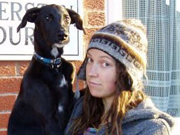
Kelda, how are you involved with Newlands?
I am an Assistant Landscape Architect at the Forestry Commission. Working with other members of the community forest team, I produce the design
plans for the Newlands sites, as well as looking at issues like site signage
and interpretation. Basically, I draw together the aspirations of everyone involved in a site, in a way that is both sensitive to the environment and inspiring for all user groups.
There is so much to consider when developing any of the Newlands sites - from physical landscapes to local people's aspirations. How exactly do you approach producing the design plans?
Once the community consultation is carried out, a set of aspirational plans is drawn up by the consultants (like Groundwork), which help to translate the local community's issues into workable changes on site. Its really useful for me to get involved at this early stage, so that I can begin to work my own design ideas in early on - it makes for a much easier transition to the final plans.
I then have to marry these plans with the vast amount of site analysis and survey work that is produced - often dealing with some tricky on-site issues that typify Newlands! I also spend quite a lot of time out on site - getting a feel for the physical layout and character of each site and meeting people who are already using the spaces regularly. This is really important to my work - it leads to much more usable and effective designs and helps me to bring the best out of each site.
Is there anything about the Newlands project that you find
challenging?
The uniqueness of each Newlands site and the broad range of user groups make it a challenging project to design for, and because all the Newlands sites are on brownfield, and often quite damaged land, there are a lot of physical issues that need to be treated sensitively. It can also be quite challenging to design for sites where the boundaries are not yet fully agreed - I need to be flexible and keep adapting as the sites change!
What are you enjoying most about working on Newlands?
Newlands is a fantastic project to work on for variety - no two sites are the same, and the wide range of people working on each site means that it can be very inspiring to design for. It has all the elements which a landscape project should have, in terms of consultation, expertise,partnership working, encouragement of innovative design and a maintenance period with continuing consultation, a formula dreamed of in theory, but rarely realised in the real world.
Something else that stands out is the number of really passionate people who are involved in Newlands - its great to be designing for sites where there is so much commitment to see the plans realised, and to make sure that they keep working, in the long-term. Its also fantastic to have the opportunity to work on some of the other design work for Newlands - like the signage and interpretation boards, which will eventually be appearing on the sites as they develop.
What are your plans for the signage on the Newlands sites?
At present, we are still discussing exactly how signage on the sites
be developed - but all of the sites will certainly have some strong
entrance signage, as well as interpretation work at prominent places - all the sites have features on their landscape, histories or environmental diversity
that we are keen to bring to peoples attention.
And your most memorable Newlands moment so far?
I was involved in the Belfield community consultation work with Groundwork and BTCV for "Make A Difference" day last year - where loads of local school children were brought to the site in Rochdale to take photographs of 'grot spots', and help to initiate changes to these problem areas. It was really inspiring to see the local children so enthusiastic about what we are doing, with some realising for the first time that these green spaces exist on their doorstep.
Experiences like that make it easier to see through any difficulties in the early stages and realise how powerful the end results of Newlands will be.